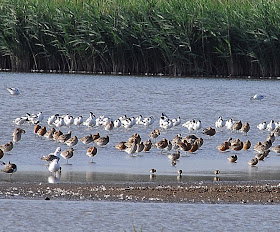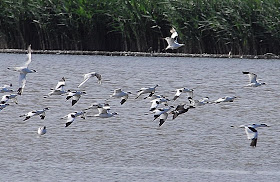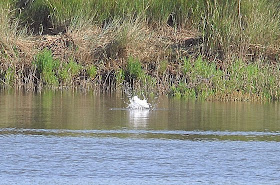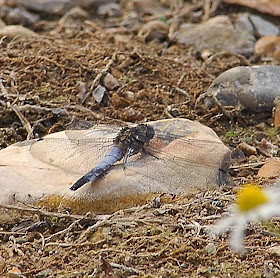A day off so a chance for an early start for North Norfolk. Having checked the moth trap at 4.00a.m. and closed it, I set off and was at Titchwell by 6.45. Good early morning light made photographing Thornham Marsh easy but hard on the Fresh marsh. I headed for the beach, having checked the reedbed by the island hide for the reported spotted crake. Nothing there apart from lapwings, moorhens, avocets and black tailed . On the brackish marsh I surprised a spoonbill and actually managed to get some photos of the bird actually moving, rather than a flight shot or one of them sleeping.
 |
| Early morning over Titchwell Fresh Marsh |
 |
| confiding spoonbill |
 |
| But not for long! |
 |
| soft light on a little egret |
 |
| same spoonbill |
At the beach there were some eiders quite close in and sanderling and dunlin along the surf. In the distance towards Brancaster were 100's of sandwich terns fishing whilst in the opposite direction, 11 arctic skuas towards Thornham, but too far for a worthwhile shot. The recently reported long tailed skua was not to be seen, so back to the Parrinder hide. Here, numerous ruff, avocets, greylags and a few little ringed plover. All good birds and now a few other birders were arriving.
 |
| eider from the beach |
 |
| sanderling |
 |
| juvenile shelduck |
 |
| godwits, dunlin, knots and avocets |
 |
| pied wagtail |
 |
| sandwich tern, dunlin, ruff etc |
 |
| meadow pipit |
 |
| ruff |
 |
| little ringed plover |
 |
| adolescent avocet |
 |
| avocet flypast |
 |
| redshank |
I left the Parrinder hide after quite a while where I had grilled all the waders but only had regulars. However, from the path, a smaller wader with ruff; a wood sandpiper. New bird for the year and gave good binocular views, showing a bright spangled plumage. Off to the island hide where the spotted crake had still not been seen. The hide was reasonably full but no one was actually looking for it. After 10 minutes, it showed, but still within the confines of the reeds. It was on view for about 20 seconds before heading back and out of sight. Apparently, it showed really well in the late afternoon, by which time I was elsewhere.
 |
| wood sandpiper |
 |
| chinese water deer on Thornham Marsh |
 |
| wood sandpiper |
 |
| spotted crake |
 |
| as far as it emerged. |
 |
| top shot: my depiction of a common tern diving. Missed! |
After a quick wander around the meadow trail I had a quick look through the contents of the moth trap before having a walk along the footpath at Choseley. Yellowhammer added to the list along with wren, robin and blackbird but plenty of activity with harvesting probably disturbed the birds, so off to Holkham. After a wander of several hundred yards, it was clear there was very little about apart from blue and great tits, so back to the car and off to Cley.
Picnic bought and eaten at Arnold's Marsh along the East bank. A bearded tit flew by and there were several 100 sandwich terns on Arnold's along with regular waders. I then fancied a bit of sea watching and although there was little movement: sandwich and common tern, cormorant, solitary knot, oystercatcher and curlew and several cormorant, I enjoyed just resting on the beach and watching the world go by.
 |
| oystercatcher |
 |
| sandwich tern, as below |
From here, I returned to the visitor's centre for a coffee before visiting the hides. Green sandpiper was added to the list as was a fly through hobby, too quick for my camera. More regular waders, with good numbers of ruff and black tailed godwit.
From here, I went around to the beach for another sea watch, but more of the same so a quick trip to Kelling Heath, which was birdless so a brief visit to Gramborough Hill where again, nothing new was added.
By now, my 4a.m. start was beginning to tell, so back to the car and home by 8.15pm.
In all, 72 species which is not too bad for July and 3 year listers in spotted crake, wood sandpiper and arctic skua.





























.JPG)

.JPG)
.JPG)




















